Knowing StrongFirst hardstyle principles and intentionally accelerating a kettlebell will undoubtedly produce more power during any lift. But having a tool that gives you real-time feedback could be the missing link between ‘just’ feeling your power and actually measuring it. Enter the PUSH Band 2.0. Athletes and coaches can use it to determine the most appropriate training weights, measure progress, and fine-tune efforts to produce maximal long-term results. Want to jump higher? Strike harder? Throw farther? Pairing the best kettlebell exercises for power and the PUSH Band may be the most effective way to do it.
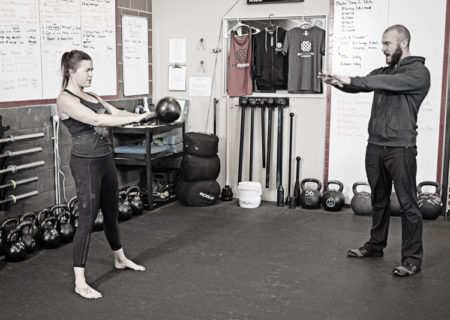
I purchased my first set of kettlebells in 2004, after my first ever Scottish Highland Games competition, as a way to practice throwing without access to traditional implements. Instead of learning the kettlebell lifts first, I actually tried throwing bells to simulate the Weight for Distance and Weight Over Bar events. It was a crazy idea, but it kind of worked.
Soon after I began learning the basic kettlebell lifts, I found that the offset handle just made sense to me as a thrower.
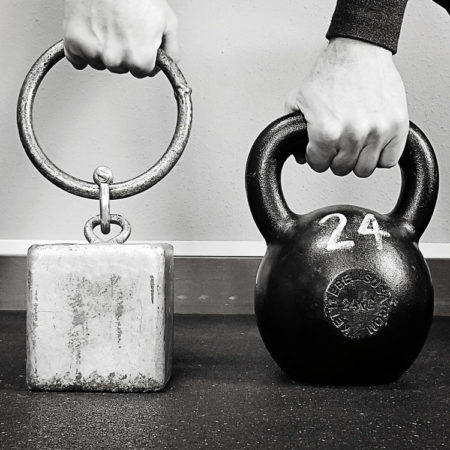
After years of plyometric jump training, sprints, Olympic lifting, and some specific velocity device training with traditional barbell lifts, I began practicing the kettlebell lifts with the intention of producing maximal power. As fellow Highland Games athlete and strength coach Dan John had suggested, I would pretend like I was throwing the bell without letting go, or imagine jumping with my heels on the ground, all while projecting effort and force into the bell. While this part of my journey had value, I knew I was missing something.
It wasn’t until 2011 that I realized the value of having a good kettlebell coach and technique cues to follow. The light bulb turned on, and I began to understand the true potential of kettlebells. After purchasing a few bells and following a solid program, I was throwing pain-free with more “pop” in my throws which resulted in more consistency and personal bests in many events. This difference in my throws on the Highland Games field resulted in my best season as a heavyweight professional athlete. Another dimension of training came alive as I had discovered a bridge between the dynamic technical aspects of the Highland Games and the gym.
In April 2018, hot off the heels of a 2017 National Championship win and 3 World Records, I found a new technology to propel my training: the PUSH Band 2.0. This small, wearable Bluetooth device allowed me to measure velocity in multiple planes of motion, not just on a particular repetition, but in changes across repetitions, sets, and training sessions. The kettlebell became my power training tool of choice.
Learning to accelerate or throw an object is an under-appreciated and often poorly trained athletic characteristic. Plus, having a newfound purpose in your training creates the fun and excitement that is sometimes needed to reach the next level. Measuring velocity and power production, if used correctly, is a true game-changer with accurate and easy-to-use technology.
Creating a Powerful Athlete
The term “power” gets thrown around quite a bit in the strength training world. So, let’s start with the literal definitions of this term:
- Power (Watts) = Force (Weight) x Velocity (Speed).
- Power = Work / Time
In essence, power is what you get when you multiply a certain amount of weight by a certain amount of speed. It’s also how much work you can do in a given amount of time. In weight training, you are either trying to move a constant weight faster or get the same work done in less time. Both result in greater power production—and hardstyle kettlebell training is an excellent way to get you there. Next, I’ll explain why, suggest the best kettlebell exercises for power, and tell you how to get started.
Why Hardstyle Kettlebell Techniques for Power Training?
- Hardstyle ballistics are all about power and technique in every rep, with clean, crisp, biomechanically sound movement patterns.
- Unilateral loading options—an uneven load elicits a new neurological/physiological pattern with emphasis on the core stabilizers. It is especially valuable for throwers but essential for everyone.
- Dissuades “pattern overload” of traditional exercises and provides a more forgiving implement compared to the barbell.
- Allows for a true ballistic training response that mimics a jump much better than a barbell.
- Lighter weight allows you to find the sweet spot of power training by taking the brakes off your movement, unlike the barbell snatch for example.
- Convenient to use almost anywhere. They can even be thrown/dropped with minimal risk of damage outside (use the neighbor’s yard, though).
- Refreshing both mentally and physically for beginners and advanced athletes.
The Best Kettlebell Exercises for Power
I based the following list on personal experience and what I feel allows people to fully “take the brakes off” and express their power without fear, over-thinking things, or having too many technical difficulties with the process.
Swings
Swings are a horizontal hip hinge translation which has been shown to have a higher correlation with maximal and explosive power (Lake and Lauder 2012), particularly when the quick application of force is the aim. (Lake and Laudner 2012; Marker 2016) The kettlebell swing (and snatch) provides unique training opportunities that require rapidly cycling between muscle contraction and relaxation and emphasize posterior chain strength and power development. (McGill and Marshall 2012; Zebis et al. 2013)
Start with basic hardstyle dead-start swings, focusing on power. Then move onto sets of continuous swings.
Snatches
The snatch couples the horizontal translation of force from the hips with a vertical redirection of force which lends itself better for vertical jumping and quick drive upward in any sport or activity. Single arm is great for these. Use lighter weights and start moving well before adding speed and “overspeed” reps. (Advanced note: the bell does not have to lock out completely overhead to get optimal power production. “Throw the bell into your crotch” is a great cue that works wonders. Move the bell with those hips!)
Push Presses
This is a classic barbell lift. Kettlebells impose unique challenges and benefits. Be sure to start light, maintain good tension and bell position in the dip, and drive hard with the legs before punching the bells up for an explosive finish. Single arm push presses first, then work into doubles if you have very good overhead shoulder mobility.
Viking Push Press
Start with the top-down approach: let the bells drop, dip quickly, and then drive them up as fast as possible. Focus on keeping an upright posture and drive up with the legs first before punching through the finish with the triceps.
Spiked Swing/Banded Swing
Here we add a light to moderate band or a trusted friend to add resistance to the top of the lift while speeding up the lowering portion eccentric of the movement for some added neurological drive, resulting in more “pop” in the next rep.
Speed Snatches
These are quite challenging and take practice. Think of this as a top-down lift where you accelerate the bell down fast, then drive up as fast as possible before resting briefly at the top again. Double bells are not recommended for this lift since the amount of force coming down, and overall risk outweighs the reward at this point.
Optimal Velocity-Based Training (The Goldilocks Zone)
True velocity and power training live on the “Speed/Strength” end of the velocity zones continuum, which is right around 30-40% of your bodyweight for kettlebell training. We don’t want, or need, to ever attempt a 1RM on kettlebell ballistics, so we should use this scale as a guide to finding the “Goldilocks” zone, or sweet spot, for optimal power development:

Over complicating this is unnecessary.
Knowing the characteristics of this spectrum is valuable to match speed with goals. To maximize power production, it is useful instantaneously measure power output. The PUSH Band delivers real-time data to help keep us in the Goldilocks zone. Not too fast, not too slow, not too heavy… just right for the power equation.
Start Power Training: Finding your Goldilocks Weight
Beginners
- Begin with the swing. An average guy can start with a very lightweight swing (say 16-20kg for most men, women 12-14kg). Most people will find the Goldilocks zone right around 30% of their body weight. Do up to 10 swings, then rest 2-5 minutes. Go up a bell size (2-4kg) until a drop-off occurs in power production (over 5% drop-off over 2-3 repetitions). You will then have a nice peak curve. The Goldilocks zone for most men will be right around 24kg for two-hand swings. Women, usually 14-16kg.
Advanced Athletes/SFGs
- Snatch. Test the same protocol but use a lighter weight—somewhere around 12kg for men and 8kg for women to start.
- Push press. Using a near snatch weight. Note that the Viking push press requires a snatch before the first press. This snatch acts as a limiter to keep you from going too heavy. Can’t snatch it? Then you aren’t ready to press it ballistically. This will take trial and error, so use the PUSH Band to guide your assessment.
So, experiment and ease into the following training.
How Many Reps?
Once you have your Goldilocks weight, you can start your velocity-based training (VBT) training in sets of 8-10 reps.
Too few reps and many will not find their rhythm with the movements. We want to work some volume into the routine, but with too many reps you will fatigue, and speed/power will drop off.
So, with the PUSH Band, a good rule of thumb would be to stop the set once the velocity numbers drop off by about 10%. Be patient—it can take up to 10 reps to get the hang of this.
How Many Sets and Exercises?
A good starting point for those new to VBT would be 2-3 sets to establish competency and then build into more volume from there on out.
This could be done 2x week in addition to strength-based programming. This is taxing on the central nervous system, so make sure to use it as a supplement to your main training… the spice to your main course.
Beginners—start with 2-4 weeks of dead-start swings or standard hardstyle swings to learn and hone your technique, and to get familiar with the PUSH device.
2-4 Weeks Intermediate Guidelines (add another set after 3rd set, after week 2):

4-6 Weeks Advanced Guidelines (add a 4th set after week 2, 5th set after week 3, then take a week off before repeating):

Here is an example of swinging a kettlebell with different styles and intentions while using the PUSH Band 2.0 to illustrate how the speed of a swing can vary:
A Real-World Application of Power
The High Striker: An Old School, All-American Test of Power
Imagine going to the county fair and playing the old-fashioned “High Striker” game where you hit a sensor with a hammer to hopefully ring the bell at the top of a board if you have the power to do so.
People love to play this game because they instantaneously get to see the result of their efforts. I mean that’s what people want to see, right? But, this is also a test of power as you are combining a considerable amount of weight with, what one hopes is, at least an equal amount of velocity. In this situation, the hammer is not so heavy as to reduce velocity, but not so light that force production is compromised. In a sense the PUSH Band allows us to return to the carnival games of our youth and play the High Striker game again. Only now the kettlebell is the hammer, we apply the force through effort, the PUSH Band is the game, and the data provided by the technology allows us to keep our eyes on the prize.
I have found that the PUSH Band also has some unique self-limiting properties which help keep people swinging well in order to produce the greatest velocity and power readings. Poor form only leads to poor numbers, much like in jumping, sprinting, or throwing techniques. You have to be smooth and rhythmic. Anyone who uses kettlebells soon figures this out, even with very little coaching. Remember this saying: “Slow is smooth, smooth is fast.”
Recap
Hopefully, you now have a better idea on how to implement VBT into your programming, and a clearer understanding of the value of power training with kettlebells.
Ultimately, it’s not how hard we can push ourselves, the number of exercises, or how complex we make our training—it’s the simplicity, planning, and application that will keep us safe and get the greatest long-term results.
Once you apply the principles, you can branch out and try other patterns, get more aggressive with the movements, and add volume if you choose. The purpose and principles never change.
This tool can be applied to a barbell or other implements with relative ease, so the potential is nearly endless. Regular real-time, high-quality coaching, video analysis, and a velocity-based training device like the PUSH Band are the future for measurable and consistent data to plan your training and get game-changing results.
If you aren’t assessing, you’re guessing. It’s as simple as that. This technology allows us to gain more insight into optimal training programs for all populations.
VBT is the real deal and the PUSH Band is a great product that allows you to train like an adult, but play like a kid on the High Striker game, all in the same session.
Why the PUSH Band is a Game-Changer
- Accuracy and reliability in measuring speed & power. Train with PUSH
- Instantaneous feedback for both the athlete and coach that is accurate and easy to follow.
- Another variable to support training auto-regulation. How is the athlete responding in real time? Is the athlete over-trained? Unfocused? Having an off day? When an athlete is not able to produce the same or increased power reading week to week, or set to set, the coach or athlete can change the training programs, adjust a variable, or discontinue a set in real-time based on PUSH data. (Fisher, 2016)
- Long-term tracking—numbers don’t lie.
- Provides another dimension for training focus. Is the athlete really giving their best? Can the coach cue them to produce more power?
- Safe and reliable for predicting 1 RM. (Ruf, Chery, & Taylor, 2018; Jidovtseff et al., 2011)
*Special thanks to Ross Dexter, MS, ATC, CSCS, SFG as a contributor/chief editor for this article and to Aaron Tandem, SFG, FMS, OTC, Pn for his editing expertise.
Addendum
I purchased the PUSH Band 2.0 (PUSH) in April 2018 and tested it on several barbell, kettlebell, and bodyweight movements with the various attachments provided. The technology and design of the PUSH provide consistent readings and ease of use that allow for effective implementation in one’s own training or with clients and athletes. Personally, the PUSH contributed to my World Record in the Highland Games’ Weight Over Bar event, along with several other personal records on the field and during training over the last six months, including a 36+ inch vertical jump and 407lb front squat at 215lbs. Much of this success I attribute to using the PUSH in my own training to provide instant feedback and precision tracking.
Specifically, I focused on using the device to monitor bar speed on my front squats and power cleans (usually 60%-80% of 1 RM), in addition to using a version of the program listed above along with various plyometric jumps and hill sprints for specific power training days. I adjusted my daily training in real-time using the device to “auto-regulate” the sessions based on the speed of the bar or implement. The technology also gave me new motivation to move the bar faster instead of just getting the reps in for the day as prescribed.
Velocity-based training (VBT) devices are commonly used to measure barbell speed during training. This technology has been widely utilized in strength and conditioning for over a decade. However, the technology has evolved to allow for more dynamic ranges of motion and has been adapted for use with less conventional training implements including kettlebells. Using this data we can measure an athlete’s readiness to train, find optimal training zones to elicit various performance outcomes, and provide accurate long-term data, potentially adding another game-changing metric to training programs for all populations. Traditionally, VBT devices attach directly to a barbell with a stringed tether measuring the vertical speed of the bar. The PUSH Band 2.0 allows the user to track velocity in all planes of motion using accelerometer and gyroscope technologies similar to those found in smartphones.
DISCLAIMER: I have no financial ties with PUSH Band nor am I supported by them in any way. This is an unsolicited summary of my experience with the PUSH Band 2.0. These protocols are for advanced kettlebell users whose technique is proficient, and ideally, have watchful coaching eyes from an SFG or skilled strength coach.
References:
- Lake, J. P., & Lauder, M. A. (2012). Kettlebell swing training improves maximal and explosive strength. The Journal of Strength & Conditioning Research, 26(8), 2228-2233.
- Lake, J. P., & Lauder, M. A. (2012). Mechanical demands of kettlebell swing exercise. The Journal of Strength & Conditioning Research, 26(12), 3209-3216.
- Marker, C. (2016) How to Get the Benefit of Depth Jumps Without Jumping. https://www.strongfirst.com/get-benefit-depth-jumps-without-jumping/. Accessed December 9, 2012.
- McGill, S. M., & Marshall, L. W. (2012). Kettlebell swing, snatch, and bottoms-up carry: back and hip muscle activation, motion, and low back loads. The Journal of Strength & Conditioning Research, 26(1), 16-27.
- Zebis, M. K., Skotte, J., Andersen, C. H., Mortensen, P., Petersen, H. H., Viskær, T. C., … & Andersen, L. L. (2013). Kettlebell swing targets semitendinosus and supine leg curl targets biceps femoris: an EMG study with rehabilitation implications. Br J Sports Med, 47(18), 1192-1198.
- Run, L., Chery, C., & Taylor, K.L. (2018). Validity and reliability of the load-velocity relationship to predict the one-repetition maximum in deadlift. Journal of Strength and Conditioning Research, 32(3):681-689.
- Jidovtseff, B., Harris, N. K., Crielaard, J.M., & Cronin, J. B. (2011). Using the load-velocity relationship for 1RM prediction. Journal of Strength and Conditioning Research, 25(1): 267-270.
- Fisher, D. L. (2016). Velocity-based training as a method of auto-regulation in collegiate athletes. (Unpublished Masters Thesis). Western Washington University, Bellingham, Washington, USA.
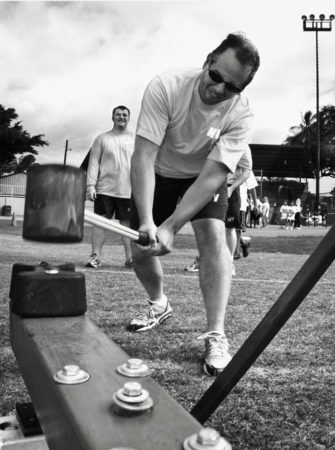
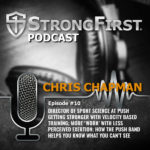
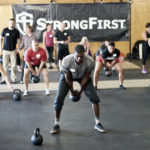




Excellent work John,
Very thorough and well put together. I’ll definitely come back to this article over and over. Lots to unpack here.
Thank you for sharing!
Good article, but I have a hard time getting on board with the current velocity based training (VBT) wearables.
The first reason for this is that they are estimating velocity based on acceleration, not directly measuring velocity, because a gyro and accelerometer are not able to directly measure displacement. Yes, yes, I have seen the comparisons of PUSH vs Tendo and such and it is supposed to have the least error of the bunch but for nearly $300 (the PUSH website lists a $299 price today, although I understand that buying through StrongFirst gets you a discount) I want more. I have seen other tools on the horizon which use a string and for $250 are as accurate as Tendo and I will save my cash for those when the time comes.
The second reason I dont want a wearable right now is that I believe the beauty of StrongFirst (Simple and Sinister at least) is that you can do it with just a few kettlebells. The existing tests and rest methods are great, no toys needed, just check your ego at the door and be honest about when it starts getting hard (which is harder for some than others). That freedom, and especially learning to listen to your body, is huge.
Overall VBT is good, and if you pay attention to Westside Barbell you will know that they use %1RM training numbers which are based on research done by Louie Simmons with a Tendo unit. At the time, before wearables, it was just cheaper to say “move the barbell as fast as possible” at a given load rather than measure every rep of every athlete. Today that is changing but I want a device that is accurate, not a device that is close enough.
Keep the good articles coming! I love science.
Great article.
That was really well done! I used the Push band and NEXUS app last summer and was impressed with the analytics and ability to adapt training as needed. You did such a great job showing the ways someone can benefit from using VBT tools. Also, excellent videos! Very helpful! Thanks for taking the time to create such a well thought out, helpful and insightful article. – Sean